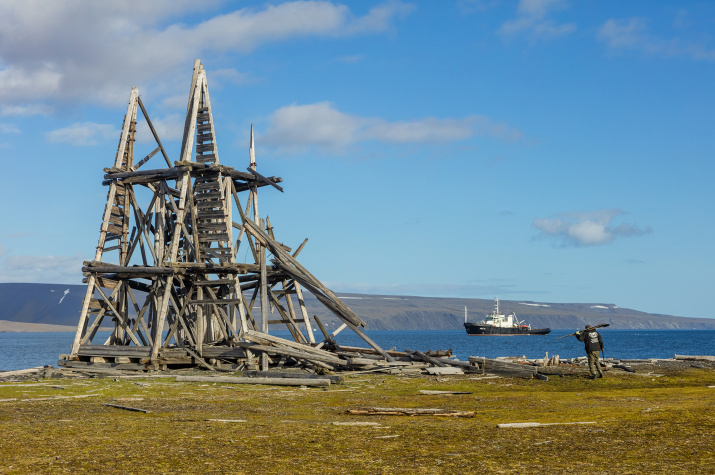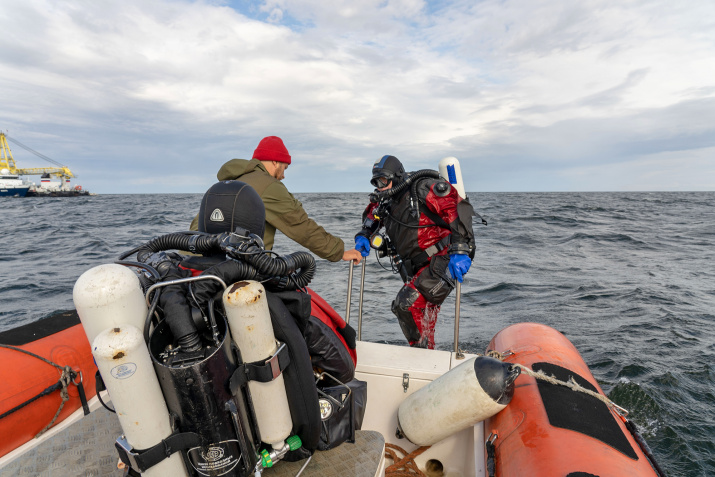Thanks to the Russian Geographical Society, Nikolai Miklouho-Maclay explored New Guinea, Grigory Potanin went to Central Mongolia, Pyotr Kozlov discovered the Tangut city of Khara-Khoto. In the 21st century, the Russian Geographical Society continues its expeditionary activities. Over the past ten years, the Society has contributed to the implementation of 2,700 expeditionary projects at the regional, federal and international levels.
In 2011, the Expeditionary Center of the Russian Geographical Society was created to coordinate expeditionary activities. In 2018 it was transformed into the Expeditionary Department. The geography of the expeditions organized by the Society covers not only Russia, but the entire globe from the Arctic to Antarctica: overland routes passed through the territory of Azerbaijan, Hungary, Kazakhstan, Mongolia, the United States, etc.
- From 2010 to 2020, 165 research projects received grant support of 309.6 million rubles from the Russian Geographical Society.
- About 167 expeditionary projects of the federal and international level have been implemented.
- 148 grants, worth over 350 million rubles, were allocated for expeditions.
- Within the framework of a joint competition of the Russian Geographical Society and the RFBR, 141 fundamental scientific research projects were supported, for which the Society allocated 210 million rubles.
- Under the auspices of the Russian Geographical Society, about 15 foreign expeditions have been implemented. Over 35 expeditions of the Russian Geographical Society took place with foreign participation.
Complex approach
There are many areas of science, which is why complex expeditions, during which scientists conduct a wide variety of research, are so effective. Based on their results, adjustments are made to geographical maps, scientific databases are replenished, recommendations for preserving the environment are drawn up, etc.
For example, three years ago a multi-year complex expedition to the Arctic "The Main Face of Russia. History, Events, People" was launched. Its participants discovered five new islands, proving that there are still undiscovered lands; and verified the transformation of the Littrov Peninsula into an island. They reconstructed the routes of the pioneers and discovered a number of historical artifacts from different years. The maximum depth of the Barents Sea was determined - 632 meters; the maps of the bottom relief, etc. were clarified.
The permanent Steppe Expedition of the Russian Geographical Society, which has been existing since 2010, is exploring territories stretching from east to west for 8.5 thousand kilometers. Its routes pass not only through Russia, but also through Mongolia, Kazakhstan, Hungary, Romania, Serbia, etc. One of the main tasks of the expedition is to study and systematize scientific data on objects of animate and inanimate nature of the Eurasian Steppe, their ecological state. Scientists record the habitats of rare and endangered animals, such as mouflons of the Ustyurt Plateau, etc. In addition, researchers study cultural and historical monuments.
Examples of other complex expeditions of the Russian Geographical Society
To study the Arctic, a complex high-latitude expedition has been organized in the Ice Camp “Barneo” for many years in a row under the auspices of the Russian Geographical Society. One of the important tasks is the search for perennial fresh ice, the amount of which is getting smaller every year. Another area of work is living organisms residing in severe conditions of eternal cold. The camp is also open to tourists.
The complex expedition "Gogland" to the Outer Islands of the Gulf of Finland has withstood eight seasons since 2013. Its participants are exploring objects of the Great Patriotic War, disarming explosive ones and transporting for restoration those that have historical value. The ecological cleaning of the islands is underway. The scientists are exploring the adjacent water area, natural and cultural attractions. The work is carried out with the assistance of the Russian Ministry of Defense.
The long-term expedition "Eastern Bastion - Kuril Ridge" is being conducted jointly with the Eastern Military District, the Russian Navy (the Pacific Fleet) and the Expeditionary Center of the Ministry of Defense of the Russian Federation. During the first season, held in 2019, its participants explored the geology, biology and volcanic activity on Iturup and Urup Islands; carried out cartographic work, discovered and studied rare samples of military fortifications and objects from the Second World War.
Floating universities
"Floating Universities" is an expeditionary form of training for undergraduate and graduate students, which involves not only practical work, but also lecture courses. At the moment, within the framework of the grant program of the Russian Geographical Society, there are several such projects in different regions.
By 2019, the "Arctic Floating University" had withstood 12 expeditions across the water area of the Russian Arctic, the last of which was attended by 58 students, graduate students and employees of scientific and educational institutions from 11 countries. In addition to oceanography, meteorology and microbiology, educational programs covered the topics of Arctic policy and law, monitoring space research, history, etc. The organizers of this annual scientific and educational marine expedition are the Arkhangelsk Regional Branch of the Russian Geographical Society, the Northern Arctic Federal University and Roshydromet.
The “Floating University of the Volga Basin” is engaged in ecological studies of the Volga and Volga reservoirs in order to find out the level and nature of anthropogenic and industrial influence. The project involves leading universities of Nizhny Novgorod and Moscow: Lomonosov Moscow State University, VGUWT, Minin University, Lobachevsky University. The work is carried out with the assistance of Roshydromet and the Institute of Applied Physics of the Russian Academy of Sciences.
The “Floating University on the Lena River” focuses on educational work and the popularization of scientific knowledge - the participants of this comprehensive scientific and educational project conduct master classes in geobotany, field meteorological observations, tourism skills, etc. for schoolchildren and teachers in remote schools and villages.
In 2011 and 2014, the “Far Eastern Floating University” (a part of the research infrastructure of the Maritime State University named after admiral G.I. Nevelskoy in Vladivostok) studied the consequences of the disaster at the Fukushima nuclear power plant. In 2015, it participated in the expedition of the Sakhalin Branch of the Russian Geographical Society as part of the program of naming unnamed geographical objects on the Kuril Islands.
Environmental issues
The expeditionary activity of the Russian Geographical Society helps to study the origins of environmental problems, and often directly contributes to their solution. In 2011–2014, an expedition to clean up the Arctic took place on the Franz Josef Land archipelago, which was organized by the Expeditionary Center of the Russian Geographical Society together with the Minprirody of Russia and other partners. On Alexandra Land alone, the expedition members collected and compacted about 1900 tons of steel barrels, processed over 4000 tons of scrap metal and almost 4800 tons of other solid waste. The project cleared Rudolf Island, Heiss Island, Hoffman and Graham Bell Islands, as well as the territory of the village of Amderma.
In 2011–2012, 2014 and 2019, four sea expeditions took place to assess the consequences of a natural and man-made disaster at the Fukushima-1 nuclear power plant in Japan. The scientific team, which included specialists from Rosatom, Rospotrebnadzor, EMERCOM of Russia and Roshydromet, carried out studies of the radiation situation in the Sea of Japan and the Kuril-Kamchatka region of the Pacific Ocean in the atmosphere and different layers of water.
In October 2020, an expedition of the Russian Geographical Society went to Kamchatka to find out the reasons for the environmental incident in the area of Khalaktyrsky beach in Avachinsky Bay. Scientists from A.N. Severtsov Institute of Ecology and Evolution RAS, specialists of the Underwater Research Center of the Russian Geographical Society and other representatives of the scientific community took part in the research.
Searching for the past
Another area of activity of the Russian Geographical Society is archeology. Work in this area has been carried out since 2011, revealing the secrets of various eras. The Kostenkovo Paleolithic expedition of 2016–2018 made it possible to study the life of the ancient people of the Don region. The international comprehensive archaeological and geographical expedition to explore the Tunnug kurgan in 2018 presented the researchers with artifacts of the early Scythians. Excavations were carried out on an area of over 5000 square meters; 820 people took part in the expedition, including 312 volunteers of the Russian Geographical Society from ten countries. In 2018–2019, a comprehensive archaeological and geographical expedition took place in the flood zone of the Sayano-Shushenskaya hydroelectric power station. The scientists examined a number of objects of the Late Scythian period and discovered 30 burials of the Xiongnu era, among which of particular interest was the burial of a mummified woman dressed in silk.
Archeological and geographical expedition «Kyzyl-Kuragino»
- The expedition project lasted five seasons from 2011 to 2015.
- Search zone for objects of cultural and historical heritage - construction of the Elegest - Kyzyl - Kuragino railway line with a length of more than 400 km.
- The excavation area covered over 4000 sq. m in Tuva and in the south of Krasnoyarsk Territory.
- About 500 leading Russian and foreign scientists-archaeologists and 2,411 volunteers from more than 50 countries took part in the project.
- More than 70 monuments of various eras have been recorded along the railway route.
On water and under water
Under the auspices of the RGS, round-the-world travels are also held. For example, in 2016–2017, the Antarctic round-the-world expedition took place on the Russian research vessel “Akademik Tryoshnikov”, dedicated to the study of 14 Antarctic islands. The project was organized by the member of the Board of Trustees of the Russian Geographical Society Frederik Paulsen. In 2019–2020, the Round-the-world Oceanographic Expedition, organized by the Ministry of Defense of the Russian Federation jointly with the Russian Geographical Society, and timed to coincide with the 200th anniversary of the discovery of Antarctica, took place. The expedition followed the route of the “Vostok” and “Mirny” ships to the Russian Antarctic station “Bellingshausen”, where the participants of the voyage celebrated the Discovery Day of the southernmost continent (January 28). During the expedition, scientists collected oceanographic and hydrometeorological data, surveyed the bottom topography, measured sea level, specified the coordinates of the South Magnetic Pole, etc.
Underwater expeditions are also of considerable interest. Since 2016, the Russian Geographical Society together with the Institute of History of Material Culture of the Russian Academy of Sciences have annually conducted an underwater archaeological and geographical expedition "Akra - the ancient city of Bosporus", whose members explore the cultural layers of the sunken ancient city in the water area of the Kerch Strait. From 2008 to 2010, a three-year research expedition organized by the Russian Geographical Society and the Foundation for Assistance to the Preservation of Lake Baikal took place. Under the leadership of the First Vice-President of the Russian Geographical Society, Artur Chilingarov, 176 dives were made almost throughout the entire water area of Lake Baikal on the “Mir-1” and “Mir-2” underwater vehicles.
The Underwater Research Center of the Russian Geographical Society, created in 2014, conducted 60 expeditions (from 2015 to 2020) in the Gulf of Finland, the White and Black Seas. Among the finds are the battleship "Portsmouth" built according to Peter I's own drawings, the German galiot "Archangel Raphael" of the 17th century, a Dutch merchant ship that was lost at the beginning of the 18th century, and others.
Expeditions of regional branches of the Russian Geographical Society
Each region can boast something special, and the numerous achievements of researchers clearly confirm this. The Krasnodar Branch of the Russian Geographical Society was revealing the secrets of the battleship "Empress Catherine the Great". The Branch of the Russian Geographical Society in the Republic of Sakha (Yakutia) sent scientists in search of the remains of mammoths and fossil predators; and the Krasnoyarsk Regional Branch of the Russian Geographical Society organized the evacuation of the Lend-Lease aircraft "Douglas C-47" from the Taimyr tundra. Over the past 10 years, more than 2,500 regional expeditions have taken place.













